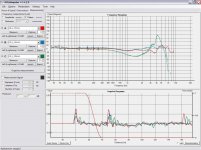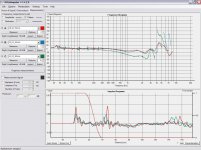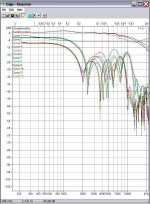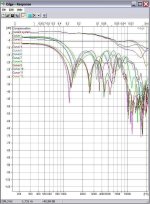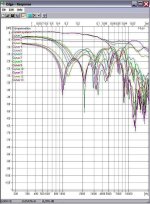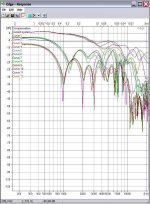I am reviving this thread, because some discussion came up here
http://www.diyaudio.com/forums/mult...upled-up-firing-speakers-307.html#post3561265
http://www.diyaudio.com/forums/mult...upled-up-firing-speakers-310.html#post3562139
http://www.diyaudio.com/forums/mult...upled-up-firing-speakers-311.html#post3562266
I will post some measurements made under anechoic (gated) conditions.
Since the speaker can be described as "floor coupled" but not as "upfiring",
it thought it would be best not to hijack the thread mentioned.
The speaker is a fullrange bending wave design, using a multipanel array of
1.2m height x 0.4m width.
Geometry of stereo triangle:
- the speaker separaration is approx. 2.3 meters
- listener's distance to the stereo base is approx. 2.3m too
- both speakers toed in to aim closely at the listener
- the omindirectional microphone has been moved from
a point close to median plane (stereo center) to the left,
in parallel to the stereo base
- distances from median plane were 0cm, 15cm, 45cm, 90cm
- microphone height is approx. 100cm
- while there is some influnece from the floor, reflections from
sidewalls and ceiling are excluded.
Nevertheless floor reflection with these speakers is very moderate.
Now some graphs:
http://www.diyaudio.com/forums/mult...upled-up-firing-speakers-307.html#post3561265
http://www.diyaudio.com/forums/mult...upled-up-firing-speakers-310.html#post3562139
http://www.diyaudio.com/forums/mult...upled-up-firing-speakers-311.html#post3562266
I will post some measurements made under anechoic (gated) conditions.
Since the speaker can be described as "floor coupled" but not as "upfiring",
it thought it would be best not to hijack the thread mentioned.
The speaker is a fullrange bending wave design, using a multipanel array of
1.2m height x 0.4m width.
Geometry of stereo triangle:
- the speaker separaration is approx. 2.3 meters
- listener's distance to the stereo base is approx. 2.3m too
- both speakers toed in to aim closely at the listener
- the omindirectional microphone has been moved from
a point close to median plane (stereo center) to the left,
in parallel to the stereo base
- distances from median plane were 0cm, 15cm, 45cm, 90cm
- microphone height is approx. 100cm
- while there is some influnece from the floor, reflections from
sidewalls and ceiling are excluded.
Nevertheless floor reflection with these speakers is very moderate.
Now some graphs:
Attachments
-
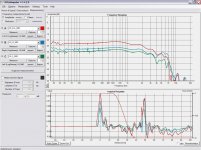 01_CloseToStereoCenter_Amplitude_Left_Right_L+R.JPG280.4 KB · Views: 479
01_CloseToStereoCenter_Amplitude_Left_Right_L+R.JPG280.4 KB · Views: 479 -
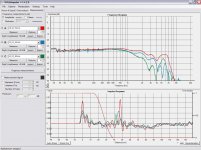 09_LeftShift_Amplitude_RightSpeaker.JPG275.1 KB · Views: 80
09_LeftShift_Amplitude_RightSpeaker.JPG275.1 KB · Views: 80 -
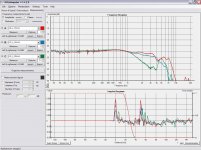 08_LeftShift_Amplitude_LeftSpeaker.JPG263.3 KB · Views: 76
08_LeftShift_Amplitude_LeftSpeaker.JPG263.3 KB · Views: 76 -
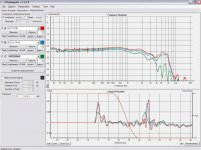 07_LeftShift_Amplitude_RightSpeaker.JPG256.2 KB · Views: 81
07_LeftShift_Amplitude_RightSpeaker.JPG256.2 KB · Views: 81 -
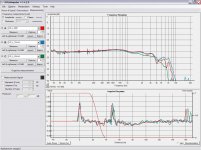 06_LeftShift_Amplitude_LeftSpeaker.JPG268.1 KB · Views: 96
06_LeftShift_Amplitude_LeftSpeaker.JPG268.1 KB · Views: 96 -
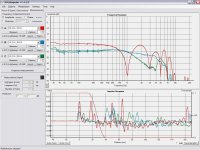 05_LeftShift_Amplitude_L+R.JPG284.3 KB · Views: 403
05_LeftShift_Amplitude_L+R.JPG284.3 KB · Views: 403 -
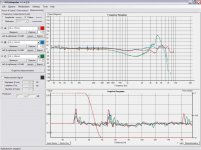 04_LeftSpeaker_PhaseDecorrelation_OnLeftShift.JPG272.1 KB · Views: 409
04_LeftSpeaker_PhaseDecorrelation_OnLeftShift.JPG272.1 KB · Views: 409 -
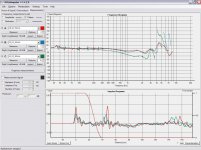 03_RightSpeaker_PhaseDecorrelation_OnLeftShift.JPG273.4 KB · Views: 411
03_RightSpeaker_PhaseDecorrelation_OnLeftShift.JPG273.4 KB · Views: 411 -
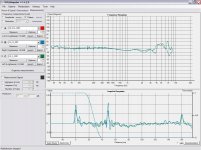 02_CloseToStereoCenter_Phase_Left_Right.JPG269.3 KB · Views: 475
02_CloseToStereoCenter_Phase_Left_Right.JPG269.3 KB · Views: 475
Last edited:
This needs some explanation! I see "LS_L_15 cmL" measured three times with different results 😕. And why aren't left and right of equal value when measured from the center position? I'm more confused than enlightened 😱.
Rudolf
Rudolf
I will post some measurements made under anechoic (gated) conditions.
It is hard to follow which picture is which condition.
Also I cannot figure if one or two speakers are playing at the same time or not and when if yes ?
Well, I came to my senses and decided that needing to use 7 poweramps just wasn't necessary for my stereo holographic soundbar project, which is now done. I did the polk thing passively and it works great. Because I've bi-amp'd, the system uses four channels of poweramp. For anyone that's interested, full details are at my website:
Bob's Website
Bob's Website
Geometry:
---------
- speaker separation approx. 2.3m
- distance from microphone to stereo base appprox. 2.3m (in center position=listening seat)
- microphone height 100cm
- method: microphone moved to the left, in parallel to stereo base
- left shift 0cm, 15cm, 45cm, 90cm
Pictures:
---------
01_CloseToStereoCenter_Amplitude_Left_Right_L+R.JPG
..amplitude in stereo center
..for both speakers, right speaker, left speaker
..centering of microphone and also toe in of speakers
..not perfect > no perfect symmetry and sum for HF
..ID
..00..red.....left speaker + right speaker (sum)
..01..blue....right speaker
..02..green...left speaker
02_CloseToStereoCenter_Phase_Left_Right.JPG
..phase in stereo center
..for left speaker, right speaker, both
..centering of microphone and also toe in of speakers
..not perfect.
..ID
..01..blue....right speaker
..02..green...left speaker
03_RightSpeaker_PhaseDecorrelation_OnLeftShift.JPG
..phase, phase for right speaker when microphone is moving to the left
..ID
..04..red.....right speaker, microphone 15cm left from center
..07..blue....right speaker, microphone 45cm left from center
..10..green...right speaker, microphone 90cm left from center
04_LeftSpeaker_PhaseDecorrelation_OnLeftShift.JPG
..phase, phase for left speaker when microphone is moving to the left
..ID
..05..red.....left speaker, microphone 15cm left from center
..08..blue....left speaker, microphone 45cm left from center
..11..green...left speaker, microphone 90cm left from center
05_LeftShift_Amplitude_L+R.JPG
..amplitude, amplitude for both speakers summing
..combing can be observed, because even at 15cm left
..from center speakers are quite phase coherent
..ID
..03..red.....left speaker + right speaker, microphone 15cm left from center
..06..blue....left speaker + right speaker, microphone 45cm left from center *
..09..green...left speaker + right speaker, microphone 90cm left from center **
* curve meaningless, because of gating only impulse response of left speaker is shown
** curve meaningless, because of gating only impulse response of left speaker is shown
06_LeftShift_Amplitude_LeftSpeaker.JPG
..amplitude, amplitude for left speaker at
..center, 15cm left and 45cm left
..ID
..02..red.....left speaker, microphone 00cm left from center
..05..blue....left speaker, microphone 15cm left from center
..08..green...left speaker, microphone 45cm left from center
07_LeftShift_Amplitude_RightSpeaker.JPG
..amplitude, amplitude for right speaker at
..center, 15cm left and 45cm left
..ID
..01..red.....right speaker, microphone 00cm left from center
..04..blue....right speaker, microphone 15cm left from center
..07..green...right speaker, microphone 45cm left from center
08_LeftShift_Amplitude_LeftSpeaker.JPG
..amplitude, amplitude for left speaker at
..15cm left, 45cm left, 90cm left
..ID
..05..red.....left speaker, microphone 15cm left from center
..08..blue....left speaker, microphone 45cm left from center
..11..green...left speaker, microphone 90cm left from center
09_LeftShift_Amplitude_RightSpeaker.JPG
..amplitude, amplitude for right speaker at
..15cm left, 45cm left, 90cm left
..ID
..04..red.....right speaker, microphone 15cm left from center
..07..blue....right speaker, microphone 45cm left from center
..10..green...right speaker, microphone 90cm left from center
-eof-
---------
- speaker separation approx. 2.3m
- distance from microphone to stereo base appprox. 2.3m (in center position=listening seat)
- microphone height 100cm
- method: microphone moved to the left, in parallel to stereo base
- left shift 0cm, 15cm, 45cm, 90cm
Pictures:
---------
01_CloseToStereoCenter_Amplitude_Left_Right_L+R.JPG
..amplitude in stereo center
..for both speakers, right speaker, left speaker
..centering of microphone and also toe in of speakers
..not perfect > no perfect symmetry and sum for HF
..ID
..00..red.....left speaker + right speaker (sum)
..01..blue....right speaker
..02..green...left speaker
02_CloseToStereoCenter_Phase_Left_Right.JPG
..phase in stereo center
..for left speaker, right speaker, both
..centering of microphone and also toe in of speakers
..not perfect.
..ID
..01..blue....right speaker
..02..green...left speaker
03_RightSpeaker_PhaseDecorrelation_OnLeftShift.JPG
..phase, phase for right speaker when microphone is moving to the left
..ID
..04..red.....right speaker, microphone 15cm left from center
..07..blue....right speaker, microphone 45cm left from center
..10..green...right speaker, microphone 90cm left from center
04_LeftSpeaker_PhaseDecorrelation_OnLeftShift.JPG
..phase, phase for left speaker when microphone is moving to the left
..ID
..05..red.....left speaker, microphone 15cm left from center
..08..blue....left speaker, microphone 45cm left from center
..11..green...left speaker, microphone 90cm left from center
05_LeftShift_Amplitude_L+R.JPG
..amplitude, amplitude for both speakers summing
..combing can be observed, because even at 15cm left
..from center speakers are quite phase coherent
..ID
..03..red.....left speaker + right speaker, microphone 15cm left from center
..06..blue....left speaker + right speaker, microphone 45cm left from center *
..09..green...left speaker + right speaker, microphone 90cm left from center **
* curve meaningless, because of gating only impulse response of left speaker is shown
** curve meaningless, because of gating only impulse response of left speaker is shown
06_LeftShift_Amplitude_LeftSpeaker.JPG
..amplitude, amplitude for left speaker at
..center, 15cm left and 45cm left
..ID
..02..red.....left speaker, microphone 00cm left from center
..05..blue....left speaker, microphone 15cm left from center
..08..green...left speaker, microphone 45cm left from center
07_LeftShift_Amplitude_RightSpeaker.JPG
..amplitude, amplitude for right speaker at
..center, 15cm left and 45cm left
..ID
..01..red.....right speaker, microphone 00cm left from center
..04..blue....right speaker, microphone 15cm left from center
..07..green...right speaker, microphone 45cm left from center
08_LeftShift_Amplitude_LeftSpeaker.JPG
..amplitude, amplitude for left speaker at
..15cm left, 45cm left, 90cm left
..ID
..05..red.....left speaker, microphone 15cm left from center
..08..blue....left speaker, microphone 45cm left from center
..11..green...left speaker, microphone 90cm left from center
09_LeftShift_Amplitude_RightSpeaker.JPG
..amplitude, amplitude for right speaker at
..15cm left, 45cm left, 90cm left
..ID
..04..red.....right speaker, microphone 15cm left from center
..07..blue....right speaker, microphone 45cm left from center
..10..green...right speaker, microphone 90cm left from center
-eof-
Attachments
-
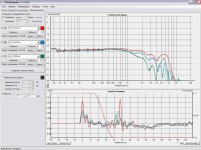 09_LeftShift_Amplitude_RightSpeaker.JPG275.1 KB · Views: 62
09_LeftShift_Amplitude_RightSpeaker.JPG275.1 KB · Views: 62 -
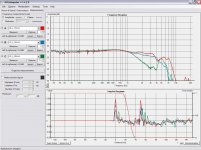 08_LeftShift_Amplitude_LeftSpeaker.JPG263.3 KB · Views: 66
08_LeftShift_Amplitude_LeftSpeaker.JPG263.3 KB · Views: 66 -
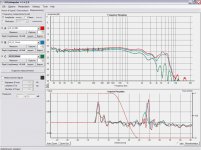 07_LeftShift_Amplitude_RightSpeaker.JPG256.2 KB · Views: 59
07_LeftShift_Amplitude_RightSpeaker.JPG256.2 KB · Views: 59 -
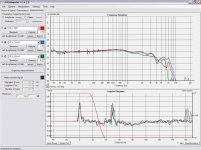 06_LeftShift_Amplitude_LeftSpeaker.JPG268.1 KB · Views: 65
06_LeftShift_Amplitude_LeftSpeaker.JPG268.1 KB · Views: 65 -
 05_LeftShift_Amplitude_L+R.JPG284.3 KB · Views: 463
05_LeftShift_Amplitude_L+R.JPG284.3 KB · Views: 463 -
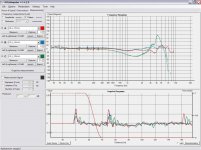 04_LeftSpeaker_PhaseDecorrelation_OnLeftShift.JPG272.1 KB · Views: 70
04_LeftSpeaker_PhaseDecorrelation_OnLeftShift.JPG272.1 KB · Views: 70 -
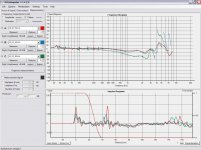 03_RightSpeaker_PhaseDecorrelation_OnLeftShift.JPG273.4 KB · Views: 69
03_RightSpeaker_PhaseDecorrelation_OnLeftShift.JPG273.4 KB · Views: 69 -
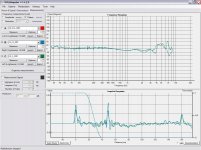 02_CloseToStereoCenter_Phase_Left_Right.JPG269.3 KB · Views: 68
02_CloseToStereoCenter_Phase_Left_Right.JPG269.3 KB · Views: 68 -
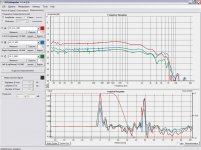 01_CloseToStereoCenter_Amplitude_Left_Right_L+R.JPG280.4 KB · Views: 78
01_CloseToStereoCenter_Amplitude_Left_Right_L+R.JPG280.4 KB · Views: 78
Thank you Oliver,
your explanations make things better understandable. Nevertheless - questions remain:
When I look at pic 8, the 90 cm (green) measurement should be next to the left speaker axis parallel to the side wall. But it has the earliest high frequency roll-off. Must have to do with the speaker to-in. But it is difficult for me to visualize the situation.
What should I see, that could not better be explained by speaker off-axis angles than by distance left from mid position?
your explanations make things better understandable. Nevertheless - questions remain:
When I look at pic 8, the 90 cm (green) measurement should be next to the left speaker axis parallel to the side wall. But it has the earliest high frequency roll-off. Must have to do with the speaker to-in. But it is difficult for me to visualize the situation.
What should I see, that could not better be explained by speaker off-axis angles than by distance left from mid position?
...
When I look at pic 8, the 90 cm (green) measurement should be next to the left speaker axis parallel to the side wall. But it has the earliest high frequency roll-off. Must have to do with the speaker to-in. But it is difficult for me to visualize the situation.
...
It has to do with toe in. Nevertheless the dispersion at HF is widened
again, although the system is fullrange (has no tweeter and no
crossover frequency).
What should I see, that could not better be explained by speaker off-axis angles than by distance left from mid position?
Nothing at a first glance.
The measurements were motivated by (also earlier) discussion with Elias.
Goal was to view the phase decorrelation patterns at distances and angles
in a usual stereo triangle situation. The price to pay was using a rather
short time window of course.
Questions were
- Is there really phase decorrelation at distances larger
than the radiating memrane's dimensions ? (Yes)
- Is there also phase decorrelation affecting interference
between speakers at the stereo center ? (No, because speakers are
quite coherent at small off axis angles)
What we can see now is how closer and farther speaker decorrelate when
moving out of the stereo center.
The speakers are pair symmetric - there is a dedicated left and right one -
but they have a broken symmetry in themselves. That means phase and amplitude
patterns change in a different manner for the closer and the farther speaker,
when moving out of center:
See Picture 03 vs. Picture 04
Note that the phase patterns remain more coherent for the left speaker,
although the angle is changing more rapidly for the left speaker
(because it comes closer and both speakers haver been toed in to aim
at the stereo center).
@Elias: Are part of the results within your expectations ?
Last edited:
I think the most interesting is figure 5 red curve.
It shows comb filtering when both speakers are playing, so as you noted the phase is quite coherent close to on-axis.
We can ponder if this is necessarily good behaviour ? It would be nice to have more phase decorrelation very close to on-axis to prevent interaural comb filtering. Because, I think, this comb filtering is the main reason for any negative aspects of stereo triangle.
Further away from on-axis the phase decorrelation seems to increase. This is good. But again, on the other hand, in a living room type of conditions, many room reflections are already quite decorrelated due to unsymmetrical furnituring features.
So, all in all, what I would like to have as an 'ideal' would be high phase decorrelation on-axis.
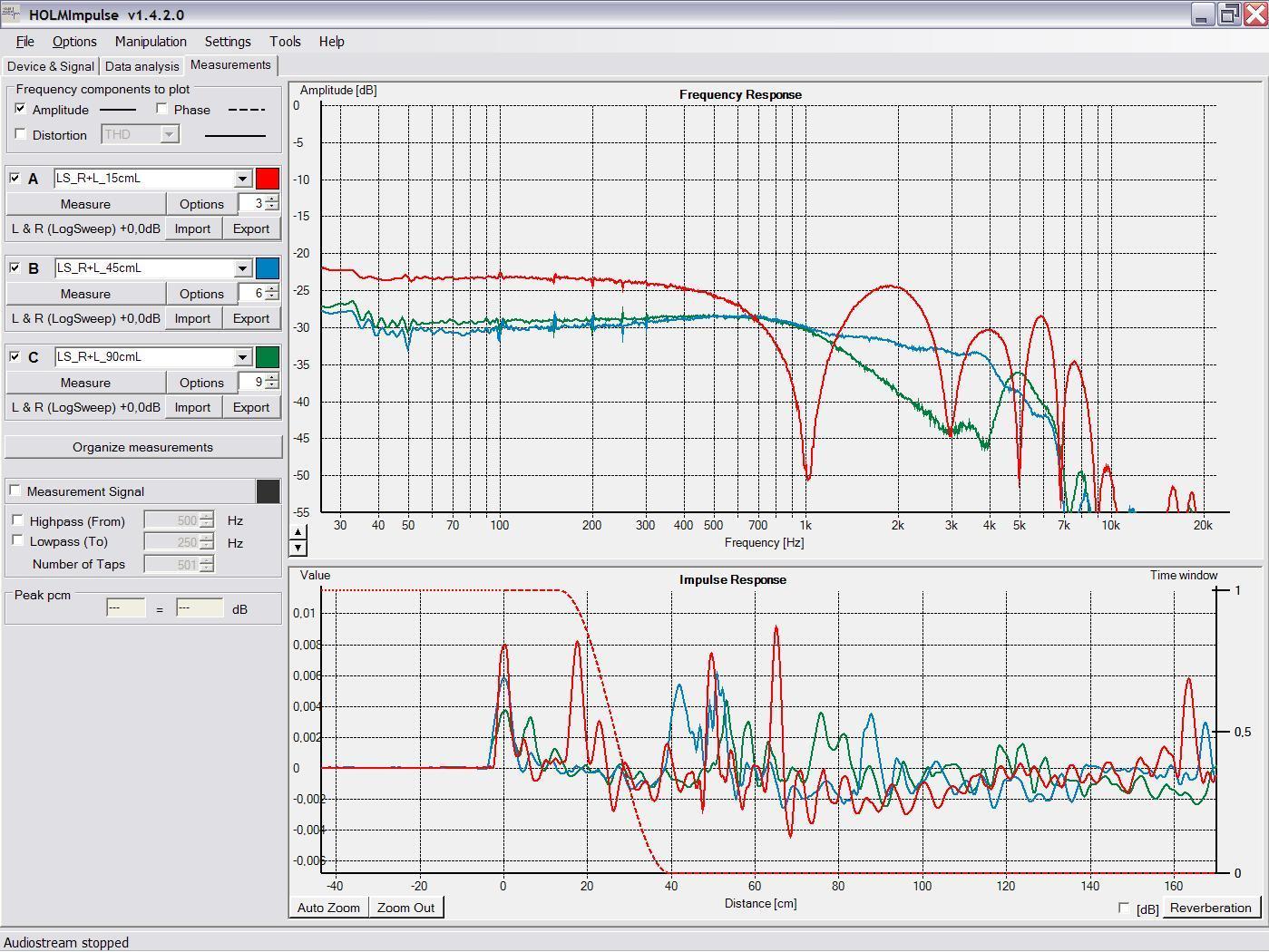
It shows comb filtering when both speakers are playing, so as you noted the phase is quite coherent close to on-axis.
We can ponder if this is necessarily good behaviour ? It would be nice to have more phase decorrelation very close to on-axis to prevent interaural comb filtering. Because, I think, this comb filtering is the main reason for any negative aspects of stereo triangle.
Further away from on-axis the phase decorrelation seems to increase. This is good. But again, on the other hand, in a living room type of conditions, many room reflections are already quite decorrelated due to unsymmetrical furnituring features.
So, all in all, what I would like to have as an 'ideal' would be high phase decorrelation on-axis.

...
I think the most interesting is figure 5 red curve.
It shows comb filtering when both speakers are playing,
so as you noted the phase is quite coherent close to on-axis.
...
It is surely not the most interesting one to me, but it is important.
It shows, that the speaker is able to present a stereophonic image in a
coherent way at the stereo center, like conventional pistonic loudspeakers
too.
This was a major point criticized by Earl some time ago, who supposed
analogously "diffuse to the sides, diffuse everywhere", which may hold
for almost all primitive DML panel types, but is not the case in this
design.
Truly, you find the typical interference artefacts for small off center
deviations, if the speaker is toed in for maximum coherence:
Can't get one without the other.
...
We can ponder if this is necessarily good behaviour ?
It would be nice to have more phase decorrelation very close to on-axis
to prevent interaural comb filtering. Because, I think, this comb filtering
is the main reason for any negative aspects of stereo triangle.
To me the pictures 03 and 04 seem even more interesting, see below.
Because of the pair symmetry and different decorrelation behaviour for the
listener moving inwards or outwards the stereo triangle, you can make correlation
more "sloppy" by reducing toe in, up to even making the speaker's membranes
parallel to the stereo base.
Since radiation in upper highs in quite "diffuse ommni" there will be no loss
in "sparkle" as with usual speakers.
To be honest, "reduced toe in", which means crossing significantly behind the listener,
is my preferred setting using these speakers, especially when listening to orchstra
and chamber ensembles. To me it is the most "believable" setting especially for
"naturalsness" of strings e.g.
There is no coloration audible, when moving to the sides in this setting.
But the most attractive seats to me are
1. Stereo Center or
2. The neighbour's place, which means some larger offset to the center.
Then you get a more "ambient" kind of presentation with imageing more softened.
Believable still, but not revealing all information concerning localization,
which is possibly recorded. I quite often listen this way for enjoyment ...
...
Further away from on-axis the phase decorrelation seems to increase.
This is good. But again, on the other hand, in a living room type of
conditions, many room reflections are already quite decorrelated due to
unsymmetrical furnituring features.
...
I doubt that. It makes a huge difference whether your speaker brings kind
of diffuse walls (in the entire room) with it, or if relies on furnishing
solely. Usual rooms are neither sufficiently diffuse nor sufficiently
symmetrical concerning "large scale"/"small scale" diffusivity to left and
right.
Maybe you can say: The better furnished and diffuse the room, the smaller
might be the difference to using a conventional speaker ... but also this kind
of speaker provides better results if you start treating the room, so it is hard
to say. This speaker is able to give "very good results" even in a "mediocre room".
The goal for designing this speaker was: Better performance in a usual living room
by getting the reverberant field more decorrelated even without excessive
room treatment.
Attachments
Last edited:
Total membrane area is approx. 40cm x 118cm width x height.
It is made up from 4 mutually independent subdivisions with
narrow seams inbetween.
There are only kind of side frames, which contribute to total
width, so including side frames we have approx. 48cm in width.
Thus the membrane or array can be said to be "self baffled".
Here's a simple sketch, showing gross dimensions:
Model 2 Fullrange Bending Wave Loudspeaker
It is made up from 4 mutually independent subdivisions with
narrow seams inbetween.
There are only kind of side frames, which contribute to total
width, so including side frames we have approx. 48cm in width.
Thus the membrane or array can be said to be "self baffled".
Here's a simple sketch, showing gross dimensions:
Model 2 Fullrange Bending Wave Loudspeaker
Last edited:
Truly, you find the typical interference artefacts for small off center
deviations, if the speaker is toed in for maximum coherence:
Can't get one without the other.
The phase 'coherence' we are talking about is at high freqs, right. I'm not convinced such coherence is needed for stereo reproduction. Let's remember from the literature that in a small room at high freqs the localisation is based on interaural average spectral energy difference. What is the role of phase at high freqs in stereo localisation ? No role.
That's why we can trade the phase coherence at high freqs to other features for a higher purpose in improving stereophonic reproduction.
The goal for designing this speaker was: Better performance in a usual living room
by getting the reverberant field more decorrelated even without excessive
room treatment.
That is a very good goal "Better performance in a usual living room". I'm also targeting there myself 😀
The phase 'coherence' we are talking about is at high freqs, right. I'm not convinced such coherence is needed for stereo reproduction.
...
I'd say at current state of discussion we both seem to be convinced,
that phase coherence between left and right speaker above say 2Khz
gets more and more meaningless. In fact it seems to have detrimental
aspects ...
If you'd be in my listening room - and some others too - i would be
surprised if you choose the "coherent highs" setting with speakers
measured above toed in fully.
I'd rather expect, that on many program material such as
orchestra and chamber ensembles said "crossing behind the listener"
setting, which has less correlation in highs, may not only be preferred
by myself.
That is a very good goal "Better performance in a usual living room". I'm also targeting there myself 😀
I said that before, i think making a good studio monitor for very dry
rooms ("sound enginering") and making a good home loudspeaker for
the usual living room ("believable enjoyment") are quite different tasks
with different priorities to bear in mind.
But i also think, that "the good home loudspeaker" should work like
a studio monitor, when used under dry conditions and auditioned from
the stereo center.
If you say "that contradicts, what you said above" you would be right ...
a pair of loudspeakers which decorrelates phase even under perfect
symmetric conditions has broken pair symmetry ... which usually is
not known as being a quality attribute.
I tried to make a pair symmetric speaker having differnt decorellation
pattern for angles inside and outside the stereo triangle.
So you can make correlation more sloppy when reducing toe in or/and by
moving out of the center (btw. no usual human being is within the stereo
center due to 20Khz all the time ...) .
But at least the reverberant portion should be sufficiently decorrelated,
even if "rough plaster at the left" and "glass at the right": Those are part
of the "usual living room."
I do not believe that "high DI" and "CD" is the key solely to solve that
problem: Speakers that radiate "more wide" get too good results in
listening tests to believe that.
Last edited:
...
What is the role of phase at high freqs in stereo localisation ? No role.
That's why we can trade the phase coherence at high freqs to other features for a higher purpose in improving stereophonic reproduction.
...
"Better performance in a usual living room". I'm also targeting there myself 😀
Maybe you would like one of these ... see pictures below.
Simulation is around 0 degrees, 45 degrees, 65 degrees.
There are always 4 curves picked at around +/- 8 degrees.
Differences in LF level because distance not constant.
This is just some "quick and dirty" prototyping of a new
idea i am thinking about:
"Mimicking dispersion properties of certain types
Bending Wave Loudpeakers
using conventional pistonic drivers."
______
But i see a problem with a speaker combing seriously at
small off axis angles: "On axis smoothness" in FR is
- also according to Toole - important for a speaker to be
accepted as "good sounding".
Maybe some kind of cascaded allpass filters would be
right for you to make some experiments in decorrelating
left and right channel at HF.
If it is beneficial (and there is "a right way to be done"),
it should be beneficial with nearly any loudspeaker ...
I personally doubt it, because non flat phase and serious
group delay may cause other problems ... but maybe there's
a "subliminal way" in making stereo more robust at HF.
Experiments using allpass filters should be quite cheap and
easy to do ... despite the problem of evaluation by listeners.
Attachments
Last edited:
Finally there is someone who can change the phase coherence in his speakers without grossly changing the size or radiation pattern. This needs to be exploited. 😀I'd say at current state of discussion we both seem to be convinced,
that phase coherence between left and right speaker above say 2Khz
gets more and more meaningless. In fact it seems to have detrimental
aspects ...
If you'd be in my listening room - and some others too - i would be
surprised if you choose the "coherent highs" setting with speakers
measured above toed in fully.
I'd rather expect, that on many program material such as
orchestra and chamber ensembles said "crossing behind the listener"
setting, which has less correlation in highs, may not only be preferred
by myself.
Oliver,
I follow you that phase coherence above 2 kHz isn't the most severe problem in loudspeaker design. But since you got some personal experience - can you describe the difference (and what makes you prefer less correlation) in more detail?
Rudolf
"Mimicking dispersion properties of certain types
Bending Wave Loudpeakers
using conventional pistonic drivers."
I think that is essential, to use conventional drivers, if wider awareness of this method is to be expected.
Maybe you publish a DIY project ? 😀
But i see a problem with a speaker combing seriously at
small off axis angles: "On axis smoothness" in FR is
- also according to Toole - important for a speaker to be
accepted as "good sounding".
Actually I strongly believe that Toole was not addressing comb filtering when talking about "On axis smoothness", but other kind of response variations.
Maybe some kind of cascaded allpass filters would be
right for you to make some experiments in decorrelating
left and right channel at HF.
If it is beneficial (and there is "a right way to be done"),
it should be beneficial with nearly any loudspeaker ...
I personally doubt it, because non flat phase and serious
group delay may cause other problems ... but maybe there's
a "subliminal way" in making stereo more robust at HF.
I think the best method to decorrelate high freqs is by using multiple of sources and not only limit oneself in two speakers.
Because the other (delayed) sounds, by which decorrelation can be achieved with, should come from other directions than the direct sound.
A linear matrix of 3 or more speakers, for example, can do this, too.
Another example to decorrelate high freqs in a small room is to aim the tweeters towards ceiling. It simulates multiple of delayed sources arriving in variety of angles.
Last edited:
- Status
- Not open for further replies.
- Home
- Loudspeakers
- Multi-Way
- Unconventional Techniques for Achieving Oustanding Stereo Imaging
